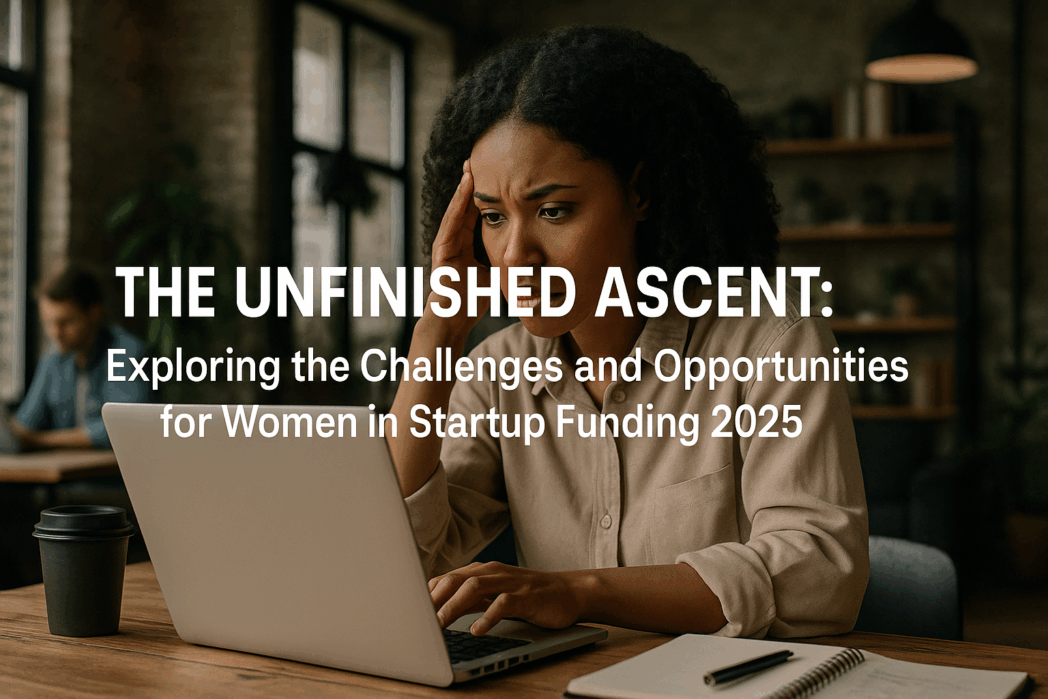Estimated reading time: 12 minutes
Key Takeaways
- Only 13.7% of million-dollar startup founders in 2025 are women, down from 15% in 2022.
- Female-led teams receive 14% less venture capital funding even with identical pitches to male-led teams.
- Women founders generate 35% higher ROI and female-led SaaS companies show 28% faster user growth.
- The global economic opportunity missed due to unequal funding exceeds $5 trillion.
- Deep tech emerges as a bright spot, with 33% of female entrepreneur funding in Europe going to this sector.
- Female angel investors in the US surged from 33.6% in 2021 to 46.7% in 2023.
Table of contents
- Key Takeaways
- The Stark Reality: Key Statistics on Women in Startup Funding 2025
- Unlocking Potential: Performance and Opportunity for Female-Led Startups
- Sector Deep Dive: Where Women are Thriving, and Where They Face Hurdles
- Unmasking the Obstacles: Drivers and Barriers to Funding for Women
- Signs of Change: Recent Trends and Glimmers of Improvement
- Paving the Way Forward: Actionable Solutions and the Outlook for Women in Funding
- Frequently Asked Questions
Step right up, curious minds, and prepare to embark on a thrilling journey into the heart of the startup world! We’re talking about the brave trailblazers, the brilliant minds, and the incredible ideas that shape our future. But hold on, there’s a mystery bubbling beneath the surface, a puzzle that has left many scratching their heads for far too long.
In a world buzzing with innovation, where new companies pop up like wildflowers after a spring rain, you’d expect everyone with a great idea to have an equal shot at success. Yet, our latest research reveals a surprising and frankly, a bit disheartening, picture. Even in 2025, women remain significantly underrepresented in startup funding.
The Stark Reality: Key Statistics on Women in Startup Funding 2025
Prepare to be amazed, and perhaps a little shocked, by the numbers shaping the world of startup funding this year. While the startup world often feels like a forward-thinking place, some statistics show a surprising step backward. In 2025, when we look at million-dollar startups – those companies that have truly hit the big time – only 13.7% of their founders are women. What’s even more surprising? This number is actually *lower* than it was in 2022, when it stood at 15%. This dip shows us that even with all the talk about equality, there are still big mountains to climb for women who dream of starting their own businesses.
Imagine two teams, one led by men and one by women, standing before a panel of investors. Both teams have amazing ideas, incredible plans, and deliver exactly the same pitch – it’s a perfect tie, right? Not quite. Research shows that female-led teams receive a startling 14% less venture capital funding even when their pitches are exactly the same as those delivered by male-led teams. It’s like running a race, but starting behind the line just because of who you are.
“Out of every 100 dollars invested, only two (or fewer!) went to companies started by women.”
Now, let’s zoom out and look at the big picture across continents. In places like Europe and the USA, which are known for their booming startup scenes, women-founded startups received a shockingly small piece of the venture capital pie in 2023. They accounted for only 2% or even less of all the venture capital funding handed out.
But the real kicker, the one that should make everyone sit up and take notice, is the massive lost opportunity. When women don’t get the same chances to build and grow their businesses, it’s not just a problem for them; it’s a problem for everyone. Experts estimate that the economic opportunity we miss out on because of this unequal funding globally is mind-boggling – it’s more than $5 trillion!
Unlocking Potential: Performance and Opportunity for Female-Led Startups
Here’s where the story takes a thrilling turn! Despite the huge challenges and the unfair funding landscape, women-led startups are not just surviving; they are absolutely thriving, often outperforming their counterparts in amazing ways. This makes the funding gap even more perplexing, and highlights a golden opportunity for savvy investors.
Imagine an investment that delivers more bang for its buck. Well, guess what? Startups led by women, when they manage to break through those stubborn funding barriers, deliver an astonishing 35% higher return on investment (ROI)! This isn’t a small difference; it’s a significant boost that shows the powerful potential waiting to be tapped.
- Performance Excellence: Female-led SaaS companies report an incredible 28% faster user growth
- Investment Paradox: Despite strong performance, these same companies receive only 11% of all SaaS investments
- Deep Tech Leadership: In Europe, 33% of all venture capital raised by female entrepreneurs goes into deep tech startups
“It’s like watching a star athlete on the field who’s scoring goals left and right, but still not getting picked for the big team.”
But wait, there’s a dazzling bright spot on the horizon: **deep tech**. This is a super exciting area that involves really advanced science and engineering, like artificial intelligence, quantum computing, or new energy sources. Think of it as the frontier of human knowledge, pushing the boundaries of what’s possible. And guess what? Women are making incredible strides here!
Why is deep tech different? One big reason is its connection to universities and research labs. These places, where new scientific breakthroughs happen, tend to have a more balanced mix of men and women working together. This means more women are getting involved in deep tech at the very beginning, which then helps them become founders of these incredible new companies.
Sector Deep Dive: Where Women are Thriving, and Where They Face Hurdles
Let’s take a closer look at different parts of the startup world to understand where women are hitting roadblocks and where they are really breaking through. It’s like exploring a map of a new country, seeing the challenging mountains and the flourishing valleys.
First, let’s talk about the Software as a Service (SaaS) industry again. While we know women-led SaaS companies show amazing user growth, this sector surprisingly has some of the lowest “gender parity.” What does that mean? It means there’s a big imbalance. The vast majority of investments in SaaS – a whopping 72% – still go to teams made up entirely of men.
This is a puzzle. If women-led SaaS companies are growing faster, why aren’t they getting more investment? It points to a deep-seated issue where investment decisions might not always be based purely on performance and potential, but on *who is in the room*.
Now, let’s pivot back to our exciting growth area: **deep tech**. This is where the landscape looks much brighter for women. As we explored before, deep tech is all about using advanced science and engineering to solve big problems. Think cutting-edge AI, new energy solutions, or amazing breakthroughs in medicine. In this area, women are truly gaining ground.
“A more diverse talent pool leads to a more diverse pool of startup leaders.”
Unmasking the Obstacles: Drivers and Barriers to Funding for Women
Why do these funding gaps persist, even when the data shows that investing in women is a smart move? It’s like a grand mystery, and we’re piecing together the clues to understand the hidden forces at play. There are several powerful drivers and stubborn barriers that make it harder for women to secure the capital they need to turn their big ideas into reality.
One of the biggest hurdles is the fact that venture capital networks – the groups of people who decide where the big money goes – often remain very male-dominated. Imagine a club where most of the members look and think alike. That’s often what the VC world has been like. We’ve already seen that a huge 72% of SaaS investments, for example, go to all-male teams.
- Network Effects: People tend to invest in those they know and those within their existing networks
- Gender Bias: Both implicit and explicit bias continue to powerfully affect decision-making in funding
- Relocation Penalty: Female founders face a 16% funding gap in traditional accelerator programs due to childcare obligations
- Supply vs. Demand Gap: Investors claim there simply aren’t enough women pitching their startups
Then there’s the pervasive issue of **gender bias**. This is a tricky one, because it can be both “implicit” and “explicit.” For instance, studies have shown that investors might ask men founders questions about *growth and potential* (called “promotion-focused” questions), while asking women founders about *risks and how they plan to avoid failure* (called “prevention-focused” questions).
However, there’s a silver lining here: the rise of “remote-first incubators” – programs that don’t require you to move – helps to narrow this gap, making it easier for women to participate and access essential startup resources.
Signs of Change: Recent Trends and Glimmers of Improvement
While the challenges are clear, the good news is that the startup world isn’t standing still. There are exciting new trends and definite signs of progress that could truly reshape the future of women in startup funding 2025.
One of the most thrilling developments is the sharp rise in the number of female angel investors. Think of angel investors as early champions – individuals who put their own money into promising young startups, often even before traditional venture capital firms step in. In the United States, the number of women angels has been growing incredibly fast: in 2023, women made up an impressive 46.7% of all angel investors, a huge jump from just 33.6% in 2021.
“When more women are making investment decisions, they are more likely to fund other women, to understand their business models, and to see the potential in ideas that might be overlooked.”
Beyond who is investing, *how* they are investing is also changing thanks to brilliant new tools and platforms. Imagine a special computer program that can help remove some of the unfairness from the funding process. That’s exactly what innovative tools are doing! Take AI validation tools like SANDBOX and PlayPal, for example. These technologies are designed to evaluate startups in a way that is “bias-resistant.”
Users of these platforms have seen 2.3 times more seed funding! This is a huge step forward because it shows that technology can be a powerful ally in leveling the playing field, making sure that good ideas get funded based on their merit, not on unconscious biases.
Paving the Way Forward: Actionable Solutions and the Outlook for Women in Funding
So, how do we push past the obstacles and truly achieve equality in startup funding? It’s clear that it will take more than just wishing for change; it requires smart, actionable solutions from everyone involved in the startup world.
For women founders themselves, there are powerful strategies they can use to boost their chances of success:
- Leveraging Networks: Actively connecting with other founders, mentors, and especially investors
- Seeking Women Investors: Target women investors or mixed-gender funds more attuned to unique challenges
- Remote Programs: Consider remote or flexible accelerator programs to eliminate relocation barriers
However, and this is a crucial point, the burden of correcting gender bias should *not* rest solely on the shoulders of women. Most experts agree that to see permanent, lasting change, the entire startup ecosystem needs to participate.
“The responsibility for correcting this imbalance should not fall solely on women themselves. It’s a collective mission for the entire startup world.”
One key area for improvement is **investor education**. Many investors might not even realize they have unconscious biases that affect their decisions. Training programs and workshops can help them identify and overcome these biases, leading to fairer evaluations of all startup pitches, regardless of the founder’s gender.
The outlook for women in startup funding, while still challenging in 2025, is also filled with immense potential. If we combine the proactive efforts of women founders with systemic interventions from investors and the wider industry – focusing on education, breaking down biases, and building more inclusive communities – we can truly unlock the incredible economic opportunity that currently lies untapped.
Frequently Asked Questions
What percentage of startup founders are women in 2025?
In 2025, only 13.7% of million-dollar startup founders are women, representing a decline from 15% in 2022. This statistic highlights the ongoing challenges in achieving gender equality in startup leadership.
Do women-led startups perform better than those led by men?
Yes, research shows that women-led startups deliver 35% higher ROI and female-led SaaS companies experience 28% faster user growth compared to their male counterparts. Despite this superior performance, they still receive significantly less funding.
Which sectors offer the best opportunities for women founders?
Deep tech emerges as the most promising sector, with 33% of female entrepreneur funding in Europe going to this area. This success is attributed to more gender-balanced university and research lab environments that feed into the startup ecosystem.
What is the main barrier preventing women from getting startup funding?
The primary barriers include male-dominated venture capital networks, both implicit and explicit gender bias, and systemic issues like the “relocation penalty” that affects mothers participating in accelerator programs. Additionally, 72% of SaaS investments still go to all-male teams.
How much economic opportunity is lost due to unequal startup funding?
Experts estimate that the global economic opportunity missed due to unequal funding exceeds $5 trillion. This massive figure represents the potential value that could be unlocked if women had equal access to startup capital.
Are there positive trends emerging for women in startup funding?
Yes, several encouraging trends include the rise of female angel investors (from 33.6% to 46.7% in the US between 2021-2023), the emergence of bias-resistant AI evaluation tools, and the growth of remote-friendly accelerator programs that eliminate geographical barriers.



